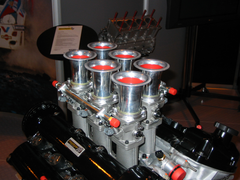


Is there a formula to work out how long the inlet trumpet needs to be?
Yes.. but it depends on where you want the torque boost in the rev-range.
this gives u a flavour.


four stroke performance tuning
A. Graham Bell.
Thanks for the info Mr W, so it looks as though fairly small changes will be made depending on the inlet length. I am looking for a broad spread but favouring 3000-5000rpm which is where most 'sprited' driving happens. So it looks like I should be aiming for ~100mm trumpets ....... but is that 100mm from intake to valve?
well i suppose it will be a lot of trial and error, PSrine indicates there is some kind of equation, but my book here doesn't seem to list a hard
and fast way to calculate it.
The best way to think about inlet tract length will be in conjuction with throttle body diameter, exhaust header setup
eg 4-2-1 will give better mid range but 4-1 will give better peak power, and thats not even concidering the effect of changin the length of the
primary pipes.
I'm assuming you have your throttle bodies already, so there is no room for manipulation there. again a very rough rule of thumb would be smaller
throttle bodies will give faster throttle response and better low/mid range, and bigger will give more top end, at the cost of mid.
apologies if you know all this. best to make/beg/steal a few different lengths and experiment a friendly dyno...
i think you can assume its 100mm from the butterfly.
[Edited on 8/8/10 by mrwibble]
Total length is from the back of the valve until a "significant change" in the inlet tract.. i.e. the end of the trumpet, or where a runner
enters a plenum. The butterfly should be ignored as at WOT when you're aiming for peak torque/power, it's fully open and does not create a
significant change in the tract
Mr.W I'm fairly certain Bell's book does indeed had some rather rudimentary formula somewhere, but it may be one of his other ones (they
tend to overlap quite a lot).
I'll see if I can dig it out..
Incidentally, the formula is as simple as calculating the length at which you'll get a standing wave at a given RPM. The constant is the speed of
the pressure wave (speed of sound).
And 100mm sounds incredibly short.. i.e. something you want for a 20k RPM peak lol
ETA: http://www.velocity-of-sound.com/velocity_of_sound/calculator1.htm
[Edited on 8/8/10 by PSpirine]
[Edited on 8/8/10 by PSpirine]
Thanks guys, that helps me a lot ..... but also confuses me a bit more 
I am looking at a Locost approach to ITBs using the existing lower inlet manifold of my Duratec V6. (see
other thread)
If all goes well, the TBs will sit directly on the top of the heads, giving a fairly straight route to the inlet valves. The inlet side of the TBs
will end up roughly 80mm from the valve so it looks as though I will need to keep the trumpets fairly short, but as you say I will probably need to
experiment with length when it all (hopefully) is running.
p.s. It becomes even more confusing when you realise that I am effectively trying to put 12 TBs onto 6 cylinders! 

[Edited on 8-8-10 by RazMan]
The Jenvey site has a little info : for a 9000 rpm engine, fron the centre of the inlet valve to the end of the air horn bell should be 350mm. 18K
bike engine half that length, 4500 rpm massive V8 twice the length. E.g inversly proportonal to the max power rpm you want from the engine. Best
option : ask jenvey to specify whay to buy from them, then just use the equivalent overall length they specified. Most kits cars are limited in the
amount of space you have, so for a car engine you probably want the longest that will fit in the engine bay!
Regards
Hugh
quote:
Originally posted by hughpinder
The Jenvey site has a little info : for a 9000 rpm engine, fron the centre of the inlet valve to the end of the air horn bell should be 350mm. 18K bike engine half that length, 4500 rpm massive V8 twice the length. E.g inversly proportonal to the max power rpm you want from the engine. Best option : ask jenvey to specify whay to buy from them, then just use the equivalent overall length they specified. Most kits cars are limited in the amount of space you have, so for a car engine you probably want the longest that will fit in the engine bay!
Regards
Hugh

Well, the chaps at Jenvey have answered my email and say that "the longer the horns you fit the better it will be"
They do a setup for the Jag V6 which is very similar ..... but no prices 


Jag V6 ITBs
Nice eh? 
quote:
Originally posted by RazMan
They do a setup for the Jag V6 which is very similar ..... but no prices
My thoughts exactly - that's why I am hoping to convert the Duratec's lower inlet manifold into Locost throttle bodies 
quote:
Originally posted by RazMan
My thoughts exactly - that's why I am hoping to convert the Duratec's lower inlet manifold into Locost throttle bodies